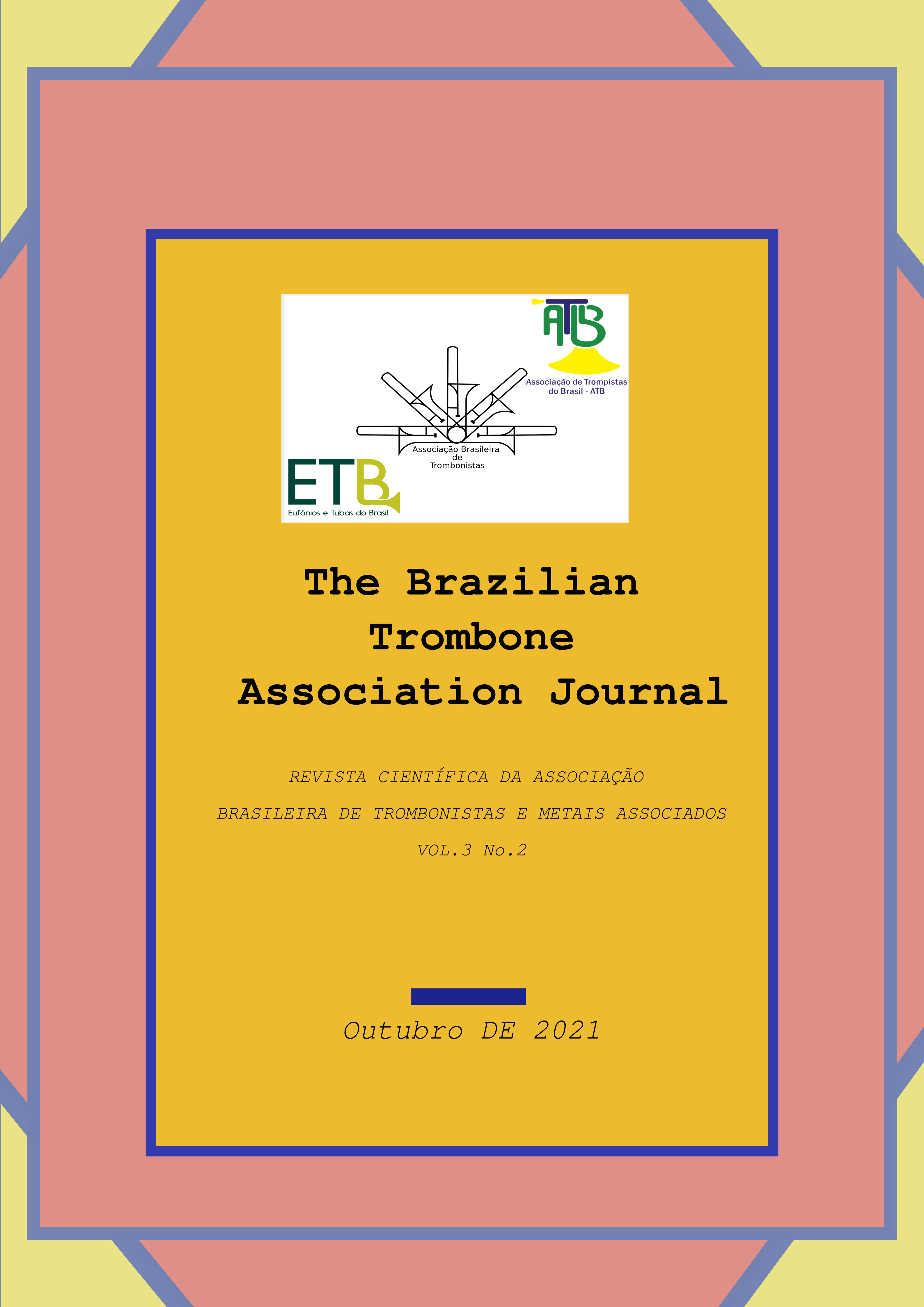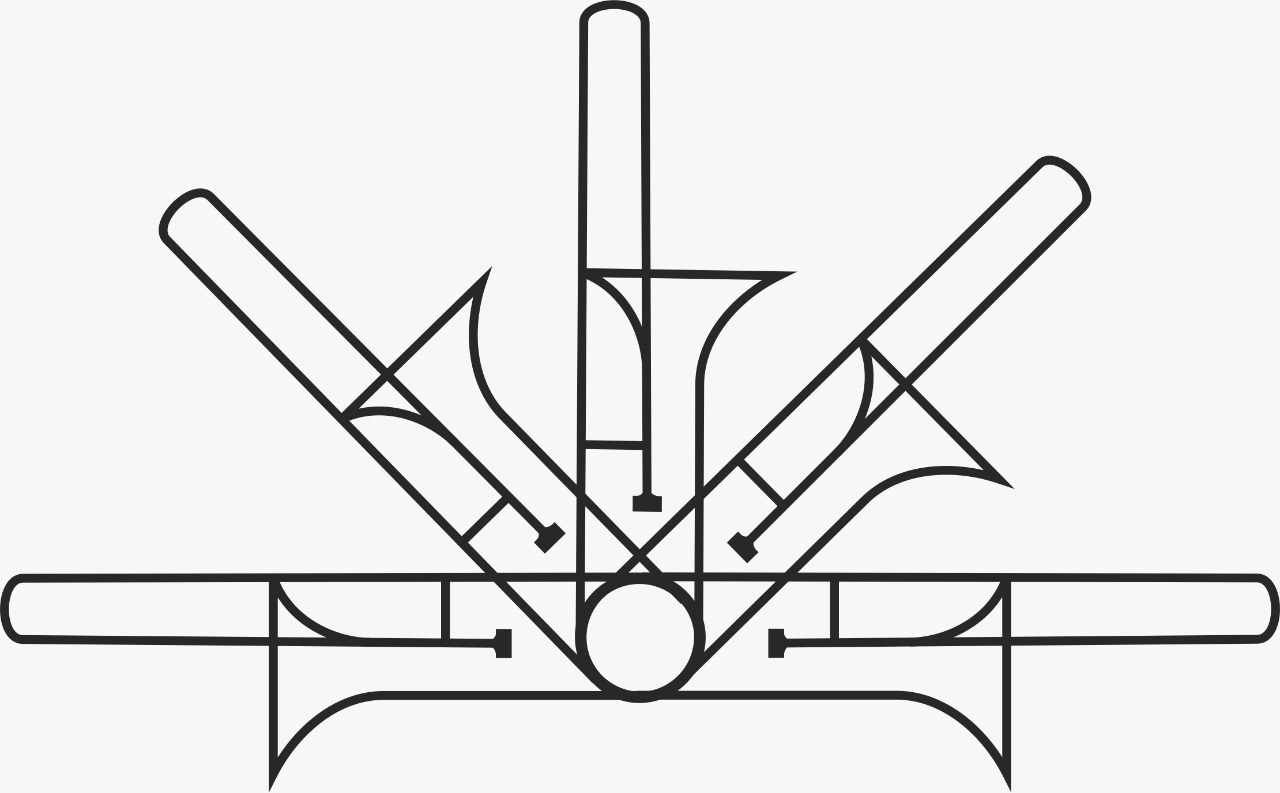Problemas de saúde em musicistas com ênfase na família dos metais
uma revisão da literatura
Palavras-chave:
Instrumentos musicais; problemas ocupacionais em musicistas; saúde do músico.Resumo
A saúde do músico, quando comparada à saúde dos atletas, é algo que necessita de muita investigação e aprofundamento, haja vista a produção no campo das ciências desportivas. Essa revisão propõe levantar as principais evidências sobre o assunto, trazendo contribuições na saúde do músico, sobretudo os instrumentistas de sopros/metal. Os temas foram divididos em dois grandes blocos: a) problemas físicos/somáticos; b) problemas psíquicos. Em ambos os casos a incidência depende, entre outros fatores, do nível de exposição e intensidade aos quais cada sujeito se encontra. Os desconfortos musculoesqueléticos e a ansiedade de performance são, de longe, os mais prevalentes de cada bloco e afetam cerca de 50% e 20% dos indivíduos respectivamente. O ambiente de ensino-aprendizagem deve gerar condições para que esse processo se dê de forma protetiva e otimizada em relação ao aproveitamento do tempo e em todas as questões que envolvam o planejamento estratégico do treinamento. Em relação à rotina profissional, sobretudo em instituições, seria ideal a participação continuada de profissionais que pudessem contribuir para uma melhor preparação tanto física quanto psíquica dos musicistas, bem como na detecção precoce de sinais e sintomas sugestivos de problemas ocupacionais, a exemplo do que já ocorre no esporte de alto rendimento.
Downloads
Referências
BOUHUYS, A. Physiology and musical instruments. Nature, v. 221, p. 1199–1204, 1969.
CHAN, C.; ACKERMANN, B. Evidence-informed physical therapy management of performance-related musculoskeletal disorders in musicians. Frontiers in Psychology, v. 5, p. 1-14, 2014.
CRUDER, C. et al. Profiling the location and extent of musicians’ pain using digital pain drawings. Pain Practice, v. 18, n. 1, p. 53-66, 2018.
DAVID, S.; et al. Spontaneous cervicothoracic epidural hematoma following prolonged Valsalva secondary to trumpet playing. The American Journal of Emergency Medicine, v. 15, n. 1, p. 73-75, 1997.
DÉTÁRI, A. et al. Psychosocial Work Environment Among Musicians and in the General Workforce in Norway. Frontiers in Psychology, v. 11, p. 1-11, 2020.
FIZ, J. A.; et al. Maximum respiratory pressures in trumpet players. CHEST, v. 1104, n. 4, p. 1203-4, 1993.
FLORES-FRANCO, R. A.; LIMAS-FRESCAS, N. E. The overused airway: lessons from a young trumpet player. Medical Problems of Performing Artists, v. 25, n. 1, p. 28-35, 2010.
FRUCHT, S. J. Embouchure dystonia: a video guide to diagnosis and evaluation. Journal of Clinical Movement Disorders, v.3, n. 10, p. 1-4, 2016.
GAMBICHLER, T.; BOMS, S.; FREITAG, M. Contact dermatitis and other skin conditions in instrumental musicians. BMC Dermatol, v. 4, n. 3, p. 1-12, 2004.
GŁOWACKA, A.; et al. The impact of the long-term playing of musical instruments on the stomatognathic system - review. Adv Clin Exp Med, v. 23, n. 1, p. 143-6, 2014.
GUNST, V.; et al. Playing wind instruments as a potential aetiologic cofactor in external cervical resorption: two case reports. International Endodontic Journal, v. 44, p. 268-82, 2011.
GÜZEL, A.; et al. Spontaneous spinal epidural hematoma after seizure: a case report. Clinical Pediatrics, v. 46, n. 3, p. 263-5, 2007.
ITO, S; et al. A case of spontaneous pneumomediastinum in a trombonist. Respiration & Circulation, v. 37, p. 1359-1362, 1989.
JUE, M. S.; KIM, Y. S.; RO, Y. S. Fiddler’s neck accompanied by allergic contact dermatitis to nickel in a viola player. Ann Dermatol, v. 22, n. 1, p. 88-90, 2010.
KOK, L. M.; et al. The occurrence of musculoskeletal complaints among professional musicians: a systematic review. Int Arch Occup Environ Health, v. 89, p. 373-396, 2016.
KOZAKEVICH, G. V.; DA SILVA, R. M. Tuberculose: revisão de literatura. Arq. Catarin Med., v. 44, n 4, p. 34-47, 2015.
KYUNG, S. K.; et al. Head-neck and mediastinal emphysema caused by playing a wind instrument. European Annals of Otorhinolaryngology - Head and Neck Diseases, v. 127, n. 6, p. 221-3, 2010.
LINDHORST, E; PAOLUCCI, V. Saxophone spermatic cord hematoma. Am J Emerg Med, v. 18, n. 4, p. 504-5, 2000.
LODHA, S.; SANTA, M.; SHARMA, P. Hypersensitivity Pneumonitis in a Saxophone Player. Chest Journal, v. 93, n. 6, p. 1322, 1988.
LOPES E PÊGO, F. P.; PÊGO, D. R. Síndrome de Burnout. Rev Bras Med Trab., v. 14, n. 2, p. 171-6, 2016.
LUACES, R.; et al. Pneumoparotid: a case report and review of the literature. Oral and Maxillofacial Surgery, v. 66, n. 2, p. 362-5, 2008.
MACIA, I.; et al. Spontaneous pneumomediastinum: 41 cases. European Journal of Cardio-thoracic Surgery, v. 31, p. 1110-4, 2007.
METE, A.; et al. Dynamic changes in optic disc morphology, choroidal thickness, anterior chamber parameters, and intraocular pressure during Valsalva maneuver. Arq Bras Oftalmol., v.79, n. 4, p. 209-13, 2016.
METERSKY, M. L.; et al. Trombone player's lung a probable new cause of hypersensitivity pneumonitis. Chest Journal, v. 138, n. 3, p. 754-756, 2010.
METZGER, F.; et al. Hypersensitivity Pneumonitis Due to Molds in a Saxophone Player. Chest Journal, v. 138, n. 3, p. 724-726, 2010.
MURPHY, J.; et al. Allergic contact dermatitis from colophony and compositae in a violinist. Contact Dermatitis, v. 40, n. 6, p. 334, 1999.
OKOSHI, K. et al. Musical instrument-associated health issues and their management. Tohoku J. Exp. Med., v. 243, p. 49-56, 2017.
ORZEL, H. Undergraduate music student stress and Burnout. Dissertação (Mestrado em Música) - The Faculty of the School of Music and Dance, San José State University. San José/Califórnia, p. 67. 2010.
OSBORNE, M. S.; GREENE, D. J.; IMMEL, D. T. Managing performance anxiety and improving mental skills in conservatoire students through performance psychology training: a pilot study. Psychology of Well-Being: Theory, Research and Practice, v. 4, n. 18, p. 1-17, 2014.
POURYAGHOUB, G.; MEHRDAD, R.; POURHOSEIN, S. Noise-induced hearing loss among professional musicians. J Occup Health, v. 59, p. 33-7, 2017.
PRASAD, K.C., VIJAYALAKSHMI, S.; PRASAD, S.C. Laryngoceles: presentations and management. Indian J Otolaryngol Head Neck, S 60, p. 303-8, 2008.
PRICE, K.; SCHARTZ, P.; WATSON, A. H. D. The effect of standing and sitting postures on breathing in brass players. SpringerPlus, v. 210, n. 3, p. 1-17, 2014.
_________, WATSON, A. H. D. Postural problems of the left shoulder in an orchestral trombonist. Work, v. 40, n. 3, p. 317-24, 2011.
RACKLEY, C. R.; MELTZER, E. B. Throw Caution to the Wind Instruments. Chest Journal, v. 139, n. 3, p. 729, 2011.
ROCHA, Sérgio. Musical Performance Anxiety (MPA). In: KALININ, Vladimir; HOCAOGLU, Cicek; MOHAMED, Shafizan. Anxiety Disorders: The New Achievements. London: IntechOpen, 2021. (53)-(66).
SANTUCCI, M. Protecting musicians from hearing damage: a review of evidence-based research. Medical Problems of Performing Artists, v. 24, n. 3, p. 103-7, 2009.
SAUNDERS, H. F. Wind parotitis. The New England Journal of Medicine, v. 289, n. 13, p. 698, 1973.
SCHINK, T.; et al. Incidence and relative risk of hearing disorders in professional musicians. Occup Environ Med, v. 71, p. 472-6, 2014.
SCHMIDTMANN, G.; et al. Intraocular pressure fluctuations in professional brass and woodwind musicians during common playing conditions. Graefes Arch. Clin. Exp. Ophthalmol., v. 249, p. 895-901, 2011.
SCHUMAN, J. S.; et al. Increased intraocular pressure and visual field defects in high resistance wind instrument players. Ophthalmology, v. 107, p. 127-133, 2000.
SIHOTA, R.; et al. Does an iridotomy provide protection against narrowing of the anterior chamber angle during Valsalva maneuver in eyes with primary angle closure. Eye (Lond), v. 22, p. 389-393, 2008.
STANHOPE, J. et al. Have musicians’ musculoskeletal symptoms been thoroughly addressed? A systematic mapping review. International Journal of Occupational Medicine and Environmental Health, v. 32, n. 3, p. 291-331, 2019.
___________, J. et al. How do we assess musician’ musculoskeletal symptoms?: a review of outcomes and tools used. Insdustrial Health, v. 57, p. 454-494, 2019.
STELL, P. M.; MARAN, A. G. D. Laryngocoele. The Journal of Laryngology & Otology, v. 89, n. 9, p. 915-924, 1975.
STRMER, C.C.; et al. Hearing loss and tinnitus in rock musicians: a Norwegian survey. Noise Health, v.17, p 411-21, 2015.
TERMSARASAB, P.; FRUCHT, S. J. Evaluation of embouchure dysfunction: experience of 139 patients at a single center. Laryngoscope, v. 126, p. 1327–1333, 2016.





